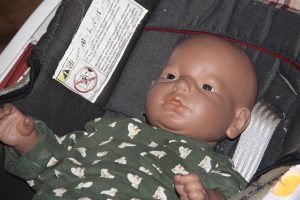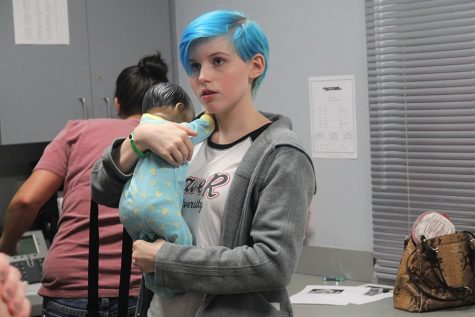Oh Baby!
Child Development classes experience parenthood with infant simulators
In the Child Development office, sophomore Katy Childers and senior Elizabeth Guevara check out the robotic babies for the weekend. “It was the best, I did everything I was supposed to do, but it was honestly really hard to take care of [the baby],” Childers said. “During the night you had to get up and take care of the baby whenever it started crying. It teaches you responsibility.”
November 28, 2015
Wailing sobs woke sophomore Kylie Birchfield from a dead sleep. Wearily sliding out of bed, Birchfield cradled the crying infant in her arms and soothed her back to sleep. The sophomore then climbed back into bed, wondering how sleep she could squeeze in before the wailing began again.
Birchfield was part of the Child Development class who experience parenthood, thanks to an infant simulator.
“The whole experience was tiring,” Birchfield said. “My afterthoughts were ‘Take this baby away from me.’ The baby woke me up around every seven or eight times a night and I didn’t even get to sleep.”
The students in Child Development had to sign up to take care of an infant simulator for 48 or more hours. This infant simulator represents a real-life baby. The students that take the baby home keep a bracelet on and it programs and reports the areas that the nurturer has failed or succeeded with while taking the baby.
“I think that the bracelet is good,” sophomore Jessica Colglazier said. “It makes the whole experience more realistic. I mean, in reality you don’t get a break with real babies so you don’t get a break with the robotic babies.”
The infant simulator tracks if the student has fed, burped, rocked and changed the baby. The robotic baby will make a coo like sound when its necessities have been taken care of. Birchfield took the baby home a weekend in October taking care of its every need.

The infant simulators acted like real babies, needing to be fed, burped and put to sleep.
“My viewpoint on real babies has changed,” sophomore Kylie Birchfield said. “At first it seems not as hard, but after you take the robotic baby home you realize that it is more needy than you thought.”
On average, the infant simulator cries at least five to six times each night like a real infant would. This is one of the many hassles that students seem to get while taking care of the baby.
“I think the target audience is for teens to prevent teen pregnancy,” Colglazier said. “It serves as a precaution to all teens.”
Since the student has a bracelet attached to them tracking their progress the students also have to take the baby everywhere they go. That includes stores and malls.
“At stores people tend to give you dirty looks,” Colglazier said. “They assume that the baby is real and think that you’re a teen that already has a child.”
Yet, the infant simulator is designed to look and act like a real baby to give it the effect of what it is like to have a real baby.
“I think it’s a good experience to help students to know what it is like to take care of a baby,” Colglazier said. “It teaches and advances students’ knowledge to know that it is not as easy as they think.”



![In the Child Development office, sophomore Katy Childers and senior Elizabeth Guevara check out the robotic babies for the weekend. “It was the best, I did everything I was supposed to do, but it was honestly really hard to take care of [the baby],” Childers said. “During the night you had to get up and take care of the baby whenever it started crying. It teaches you responsibility.”](https://rhsrumbler.com/wp-content/uploads/2015/11/23_ChildDevelopment-KL-900x600.jpg)
